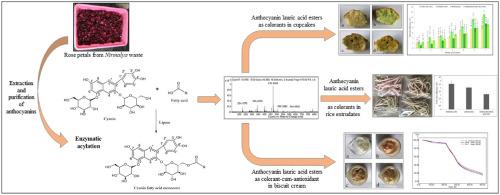Food Bioscience ( IF 5.2 ) Pub Date : 2020-12-23 , DOI: 10.1016/j.fbio.2020.100852 Sandesh J. Marathe , Nirali N. Shah , Seema R. Bajaj , Rekha S. Singhal

|
Anthocyanins were extracted from red rose petals collected from floral waste, and were esterified with fatty acids using the lipase Fermase CALB™ 10000 to enhance their lipophilicity. The process parameters for the extraction of anthocyanin were optimized for extraction time, nature of the solvent, substrate to solvent ratio, and concentration of citric acid. Anthocyanins were purified using resins. Acylated anthocyanins were primarily detected using TLC followed by confirmation using LC-MS analysis. Optimization of the reaction parameters was carried out by one-factor-at-a-time method using HPTLC. An optimized molar conversion of 63% of anthocyanins to its fatty acid esters was achieved in acetonitrile at 40 °C with a cyanidin:lauric acid molar ratio of 1:100 and an enzyme and molecular sieve load of 20 mg/mL and 100 mg/mL, respectively, in 24 h. The antioxidant activity of anthocyanin and its fatty acid esters assessed using DPPH, ABTS and FRAP assays showed retention in the activity upon acylation. The use of lauric acid esters of anthocyanins was studied as a colorant in emulsion-based foods such as cupcakes and sandwich biscuit cream (filling). The antioxidant effect of the esterified anthocyanins assessed by TGA, manifested improved stability on the thermo-oxidative lipid peroxidation of the biscuit cream. Anthocyanins and its fatty acid esters were also studied as pre-extrusion colorants in rice extrudates, where the esters showed superior color stability to thermal processing in comparison to anthocyanins. Anthocyanin fatty acid esters can thus find application in functional foods.
中文翻译:

从花卉废料中分离出的花色苷的酯化:酯的表征及其在各种食品系统中的应用
花青素从收集自花卉废料的红色玫瑰花瓣中提取,并使用脂肪酶Fermase CALB™10000与脂肪酸酯化,以增强其亲脂性。花青素的提取工艺参数针对提取时间,溶剂性质,底物与溶剂的比例以及柠檬酸浓度进行了优化。花青苷使用树脂纯化。主要使用TLC检测酰化花色苷,然后使用LC-MS分析进行确认。使用HPTLC通过一次一因素法进行反应参数的优化。在40°C的乙腈中,花青素:月桂酸摩尔比为1:100,酶和分子筛负载分别为20 mg / mL和100 mg //,可实现63%的花青苷向其脂肪酸酯的最佳摩尔转化率。毫升,分别在24小时内。使用DPPH,ABTS和FRAP分析评估的花色苷及其脂肪酸酯的抗氧化活性显示出酰化后的活性得以保留。研究了花青素月桂酸酯在乳化食品(例如纸杯蛋糕和三明治饼干奶油(填充))中作为着色剂的用途。通过TGA评估的酯化花色苷的抗氧化作用表现出对饼干奶油的热氧化脂质过氧化的改善的稳定性。还研究了花青素及其脂肪酸酯作为大米挤出物中的预挤出着色剂,与花青素相比,该酯在热加工中表现出优异的颜色稳定性。花青苷脂肪酸酯因此可以在功能性食品中找到应用。ABTS和FRAP分析显示酰化后保留了活性。研究了花青素月桂酸酯在乳化食品(例如纸杯蛋糕和三明治饼干奶油(填充))中作为着色剂的用途。通过TGA评估的酯化花色苷的抗氧化作用表现出对饼干奶油的热氧化脂质过氧化的改善的稳定性。还研究了花青素及其脂肪酸酯作为大米挤出物中的预挤出着色剂,与花青素相比,该酯在热加工中表现出优异的颜色稳定性。花青苷脂肪酸酯因此可以在功能性食品中找到应用。ABTS和FRAP分析显示酰化后保留了活性。研究了花青素月桂酸酯在乳化食品(例如纸杯蛋糕和三明治饼干奶油(填充))中作为着色剂的用途。通过TGA评估的酯化花色苷的抗氧化作用表现出对饼干奶油的热氧化脂质过氧化的改善的稳定性。还研究了花青素及其脂肪酸酯作为大米挤出物中的预挤出着色剂,与花青素相比,该酯在热加工中表现出优异的颜色稳定性。花青苷脂肪酸酯因此可以在功能性食品中找到应用。研究了花青素月桂酸酯在乳化食品(例如纸杯蛋糕和三明治饼干奶油(填充))中作为着色剂的用途。通过TGA评估的酯化花色苷的抗氧化作用表现出对饼干奶油的热氧化脂质过氧化的改善的稳定性。还研究了花青素及其脂肪酸酯作为大米挤出物中的预挤出着色剂,与花青素相比,该酯在热加工中表现出优异的颜色稳定性。花青苷脂肪酸酯因此可以在功能性食品中找到应用。研究了花青素月桂酸酯在乳化食品(例如纸杯蛋糕和三明治饼干奶油(填充))中作为着色剂的用途。通过TGA评估的酯化花色苷的抗氧化作用表现出对饼干奶油的热氧化脂质过氧化的改善的稳定性。还研究了花青素及其脂肪酸酯作为大米挤出物中的预挤出着色剂,与花青素相比,该酯在热加工中表现出优异的颜色稳定性。花青苷脂肪酸酯因此可以在功能性食品中找到应用。还研究了花青素及其脂肪酸酯作为大米挤出物中的预挤出着色剂,与花青素相比,该酯在热加工中表现出优异的颜色稳定性。花青苷脂肪酸酯因此可以在功能性食品中找到应用。还研究了花青素及其脂肪酸酯作为大米挤出物中的预挤出着色剂,与花青素相比,该酯在热加工中表现出优异的颜色稳定性。花青苷脂肪酸酯因此可以在功能性食品中找到应用。


























 京公网安备 11010802027423号
京公网安备 11010802027423号